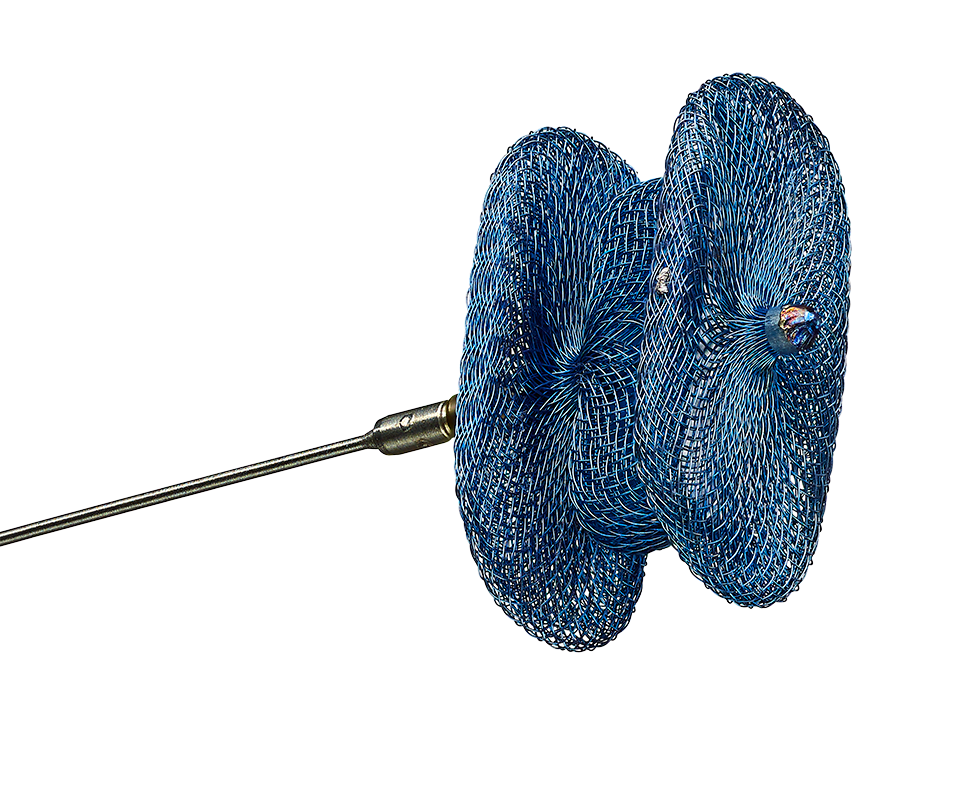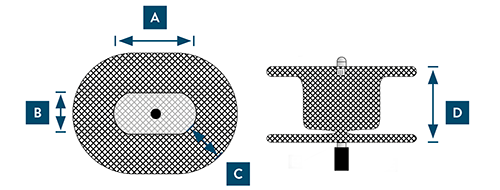Delivering one-class improvement in the NYHA classification in up to 90% of patients1,2,3,4 and an effective solution for a wide range of PVL morphologies1,5,6
Paravalvular leaks can be found in a variety of shapes and sizes. To tackle the leaks and fill the gaps of different morphologies, the Amplatzer Valvular Plug III is designed in a rectangular oval shape that fits a wide range of paravalvular leaks (PVL). As such, the Amplatzer Valvular Plug III can provide effective closure in over 90% of patients at 30 day follow up.6,7,8
A Solution To A Key Issue
Around the world, paravalvular leaks are a common and challenging problem: paravalvular leaks occur in 7% to 17% of mitral valve replacements (MVRs) and 5% to 10% of aortic valve replacements (AVRs).9 By providing an effective solution to this key issue, the Amplatzer Valvular Plug III is improving life quality and longevity to an increasing number of patients.1,2,3,4

Ordering Information
Amplatzer™ Valvular Plug III

| Model Number | Type Amplatzer Valvular Plug III | A Waist Long Axis (mm) | B Waist Short Axis (mm) | C Overhang (mm) | D Plug Length (+1.0 mm / -0.5 mm) |
|---|---|---|---|---|---|
| 9-APVL3-042 | 4x2 mm | 4 | 2 | 2 | 6.5 |
| 9-APVL3-063 | 6x3 mm | 6 | 3 | 2 | 6.5 |
| 9-APVL3-084 | 8x4 mm | 8 | 4 | 2 | 6.5 |
| 9-APVL3-103 | 10x3 mm | 10 | 3 | 2 | 6.5 |
| 9-APVL3-105 | 10x5 mm | 10 | 5 | 2 | 6.5 |
| 9-APVL3-123 | 12x3 mm | 12 | 3 | 2 | 6.5 |
| 9-APVL3-125 | 12x5 mm | 12 | 5 | 2 | 6.5 |
| 9-APVL3-143 | 14x3 mm | 14 | 3 | 2 | 6.5 |
| 9-APVL3-145 | 14x5 mm | 14 | 5 | 2 | 6.5 |
References
- Calvert et al. Percutaneous device closure of paravalvular leak. Circulation. 2016;134(13):934-944.
- Yildirim A, Goktekin O, Gorgulu S, et al. A new specific device in transcatheter prosthetic paravalvular leak closure: a prospective two-center trial. Catheter Cardiovasc Interv. 2016;88(4):618-624.
- Smolka G, Pysz P, Kozłowski M, et al. Transcatheter closure of paravalvular leaks using a paravalvular leak device - a prospective Polish registry. Postepy Kardiol Interwencyjnej. 2016;12(2):128-134.
- Angulo-Llanos R, Sarnago-Cebada F, Rivera AR, et al. Two-Year Follow Up After Surgical Versus Percutaneous Paravalvular Leak Closure: A Non-Randomized Analysis. Catheterization and cardiovascular interventions: official journal of the Society for Cardiac Angiography & Interventions. 2016;88(4):626-634.
- Garcia et al. Outcomes and predictors of success and complications for paravalvular leak closure: an analysis of the Spanish real-world paravalvular Leaks closure (HOLE) registry. EuroIntervention. 2017;12(16):1962-1968.
- Davidavicius G, Rucinskas K, Drasutiene A, et al. Hybrid approach for transcatheter paravalvular leak closure of mitral prosthesis in high-risk patients through transapical access. J Thorac Cardiovasc Surg. 2014;148(5):1965-1969.
- Smolka G, Pysz P, Jasiński M, et al. Multiplug paravalvular leak closure using Amplatzer Vascular Plugs III: A prospective registry. Catheter Cardiovasc Interv. 2016;87(3):478-487.
- Werner N, Zeymer U, Fraiture B, et al. Interventional treatment of paravalvular regurgitation by plug implantation following prosthetic valve replacement: a single-center experience. Clin Res Cardiol. 2018.
- Cruz-Gonzalez I, Rama-Merchan JC, Rodriguez-Collado J, et al. Transcatheter closure of paravalvular leaks: state of the art. Neth Heart J. 2017;25(2):116-124.
MAT-2312530 v1.0



